Are you thinking about raising quail on your farm or homestead? In this article, we discuss all you need to know about these delightful little birds.
To raise quail, you need a secure, warm enclosure, feeders, waterers, and nesting boxes if you want the quail to lay eggs.
This exotic dual-purpose bird is easy to raise and profitable to own. Raising quail for eggs and meat is gaining popularity day by day. Quails don’t need much space, require little food and care, and can be kept in rural and urban areas.
Quail are awesome for many reasons; let’s talk about why quail might end up being the most prized poultry on your farm.
Table of Contents
Why Raise Quail?
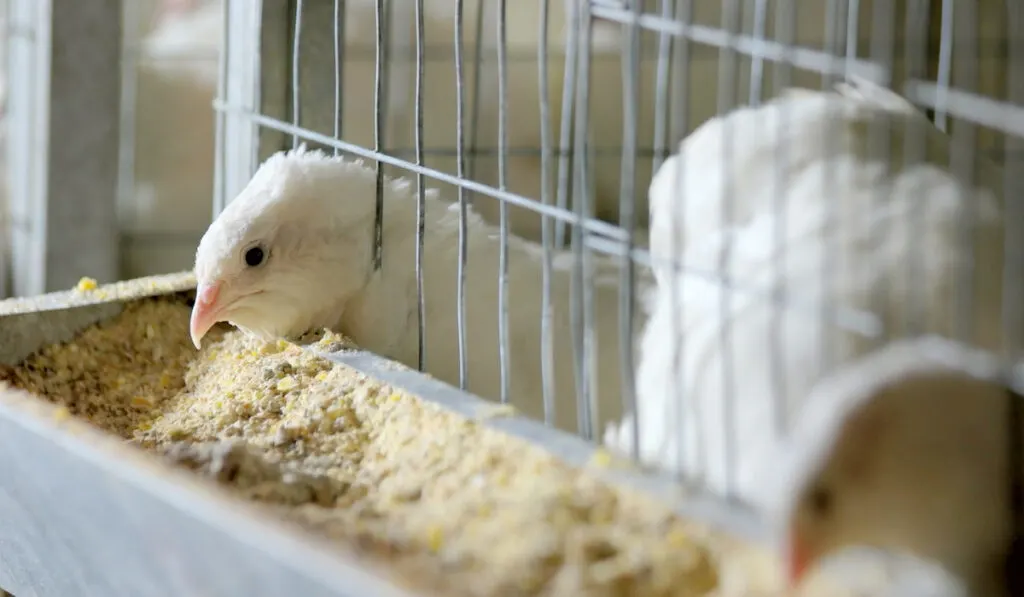
There are many reasons why you should raise quail.
Quail don’t need to be kept in a large area. Most quail breeders recommend keeping them in large cages. Five quail eggs equal one chicken egg. Quail meat is considered a delicacy and sought after, providing food for your family farm.
Quail meat and eggs can be sold at farmer’s markets and to high-end restaurants. Breeding quail can be profitable when the offspring can be sold to hunting or nature preserves for wildlife release.
How to Raise Quail
While raising quail is almost the same as raising chickens, there are a few differences in going about it.
Quail are small wildfowl that can easily be raised in a backyard cage in urban areas. Unlike chickens, most city ordinances don’t restrict raising quail. Quail are small, quiet, even-tempered birds that produce about five to six eggs per week.
Quail are easy to raise, and before you know it, you will be enjoying their boiled little eggs each week. Before you start, decide if you want to buy adult birds or eggs for hatching. A mature quail can cost $5, and you can get 50 eggs for hatching at $20.
There are added costs and equipment when hatching eggs, and you spend a lot of time caring for the chicks. If it’s your first time raising quail, purchasing some mature birds is better than hatching eggs. However, before you start your first covey (a group of quail), there are a few things to consider that will help you prepare.
Select the Breed

Coturnix is the most recommended breed to raise. They are good egg producers, can also be raised for meat, and are easy to look after. When looking for a quail breed that lays bigger eggs, you should raise the jumbo Coturnix.
The Coturnix breed is also known as the Japanese quail. There are different colored Coturnix quail like the tuxedo quail, which is brown and white.
The Coturnix quail breed generally starts laying eggs at 6-8 weeks when they mature. After eight weeks, they will generally lay one egg each day. Quail eggs are available much sooner than chicken eggs. Quail will lay their first egg at two months compared to chickens that take 18-20 weeks.
Quail will live for around two years, but some breeders say 3-4 years.
If you’re unsure, you want to go with Coturnix or other popular breeds like the Scaled Quail, Bobwhite Quail, and Gambel’s Quail. However, Coturnix quail is the most popular and recommended starter breed.
Equipment for raising quail is not much different from the equipment needed to raise chickens or other poultry. You need:
- A place for them to live (elevated cages or a floor pen)
- Feeders and waterers
- A flight pen if you are raising birds that will be released
- Quail chicks need a heat lamp
Quail Housing Options
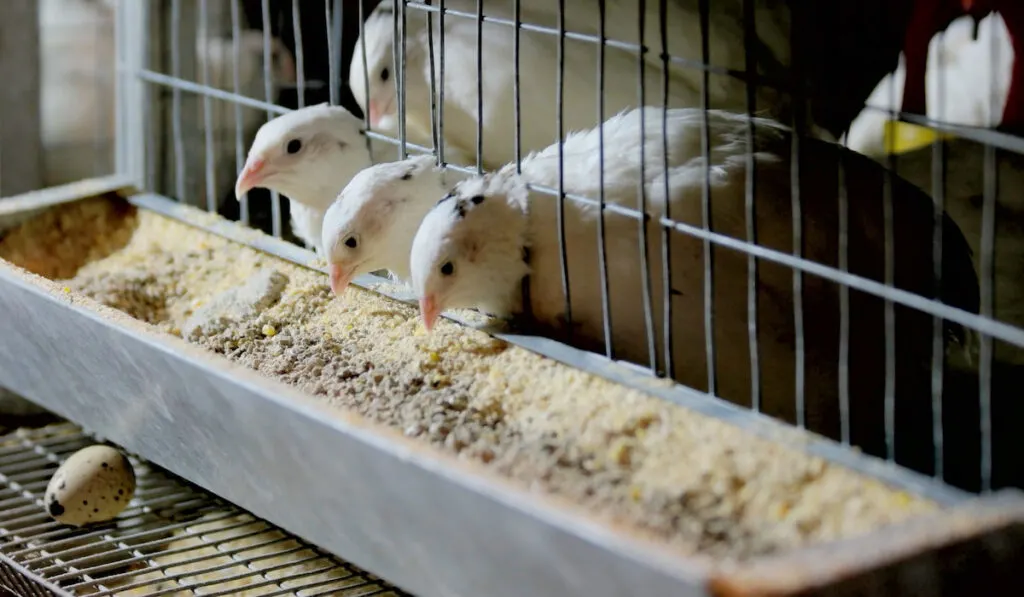
You can raise six quail in the same space required for raising a chicken. If you plan to raise quails commercially, then the numbers will be higher.
There are two options for quail pens, individual or colony cages elevated off the floor. When breeding quail in floor pens, you will not produce as well as caged breeders, and the quail are exposed to more health problems than birds kept off the floor. You can also use a rabbit hutch to house quail.
Quail in floor pens each need 1 square foot of space per bird.
When raising quails in colony cages, several females and males are kept together.
That makes it harder to know who the most productive birds in the cages are.
When the birds are in individual cages, it’s just a single breeder pair together, making it easy to know who is productive.
With individual cages, you need more infrastructure, space, and birds to keep the one-to-one ratio. When raising quail in cages, it has the advantage of letting waste drop to the floor and away from the birds.
Most quail cages are made of open mesh wire, as quails need shelter but plenty of air. When using an elevated cage to raise your quail, clear the space underneath the cage to place straw. Straw helps collect waste dropped down from the cage.
The elevated cage is set up to prevent diseases. Quail waste is high in ammonia that is harmful to the quail.
Quail kept in a colony, or individual cages need 6 square inches of space per bird.
Brooder
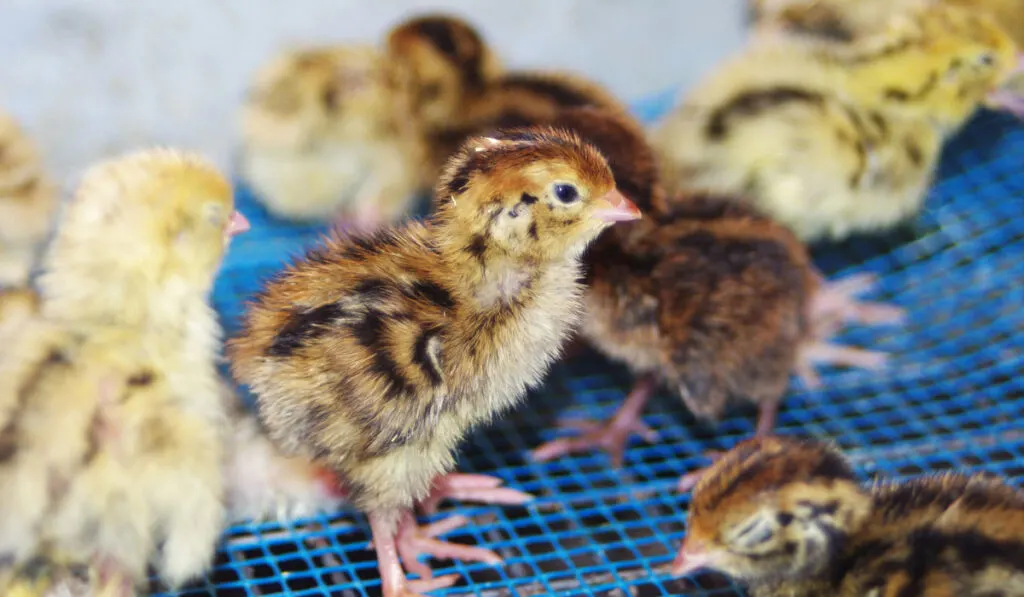
Your brooder needs to be dry, warm, clean, and predator-proof in a well-ventilated space with no drafts. It is recommended to have:
- Six chicks per square foot in the first two weeks in the brooder
- From weeks two to six to have four chicks per square foot in the brooder
- After six weeks to have three chicks per square foot in the brooder
Provide a heat lamp to maintain brooder temperature at a chick level of 95 to 97°F in the first week. You can reduce the brooder temperature by 5°F per week, down to 75°F.
Place bedding in the brooder like wood shavings or rice hull but never use paper or cardboard; they are slick and can cause leg injuries.
Place a light in the brooder, too. Keeping a 100-watt bulb on continuously for the first three days will help chicks find food and water.
Keep a low-intensity light on after this time to keep cannibalism at a minimum. This allows egg production in the fall and winter months. Quails need 15 hours of light per day to produce eggs, but if there is light for longer than that, the quail will be stressed from lack of sleep.
Feed your quail chicks a chick starter feed until they are six to eight weeks old. Chick starter feeds provide more nutrients which is what the chicks need. Buy turkey or chicken starters and grind them up into smaller grains so that the quail chicks can eat them. Any high-protein starter feed should be fine.
Feeding and Watering
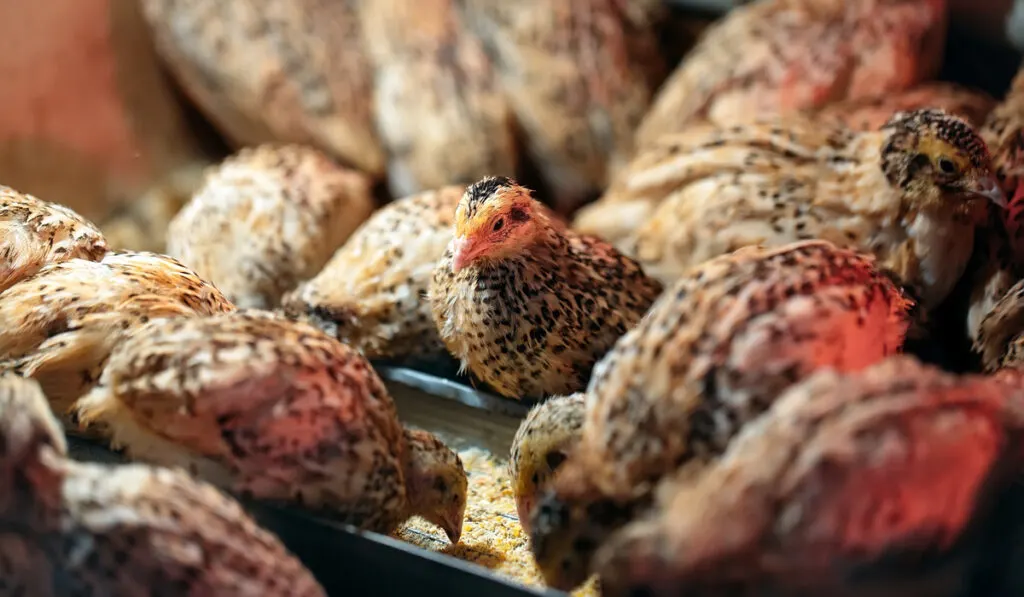
Your quail should always have access to fresh, clean water and food.
Your waterers and feeders should be elevated off the ground almost at the same height as the quail’s backs. When quails are kept in a floor pen, place a wire rack under the waterers and feeders so the quails are not standing in waste under them.
You should feed your quail a good-quality commercial quail feed that you can buy from any feed store or online. Feeding your substandard quail feed will only cause health problems later. This is particularly important when quail are raised for laying eggs or breeding.
If it is hard to find high-quality quail feed, you can try turkey feed instead. Turkey feed has a higher protein content than chicken feed which makes it perfect for quail. When buying turkey feed, do not buy the medicated kind.
Game bird and quail feeds usually contain grains (barley, wheat, oats, and rye), cracked corn, safflower seed millet, milo, sunflower seeds, sunflower kernels, oat grouts, and popcorn.
Make sure to give your quail plenty of food and pay attention to the texture. Feeding quail is easy; they can’t be over-fed because they will stop eating when they are full.
When it comes to the size of their food, quails are fussy if the grains are too big or too small; they will refuse to eat them. Quail foods need to be perfectly sized.
When they eat, they make a big mess flicking food everywhere, so make sure to place the feed in a feeder deep enough so that nothing goes to waste.
Adult quail need to eat 20 to 25 grams of food a day.
If you buy quail feed that is in a pellet form, grind the food into small pieces. Ensure the pieces are the same sizes, or the quail will pick and choose what to eat and leave the rest of the food. When the quail pick and choose what they want to eat, they won’t get all the nutrition they need.
Also, provide your quail with a source of grit, like a crushed oyster shell.
Don’t feed the quail a mashed feed; it can be too powdery. The powder can also easily get stuck on the quail’s feet and in between their toes which can cause infections.
Make sure to clean and refill the water containers daily. Ensure that the quail chicks cannot drown in the water container and have easy access to the water. Some quail breeders put marbles in the waterer to prevent the quail from drowning.
Supplemental Food
You can offer your quail some vegetables and fruit. Around 20% of a quail’s diet consists of fruits, vegetables, leaves, and other roughage.
Plant some berry shrubs like currant, blackberry, manzanita, huckleberry, Oregon grapes, serviceberry, snowberry, and salad.
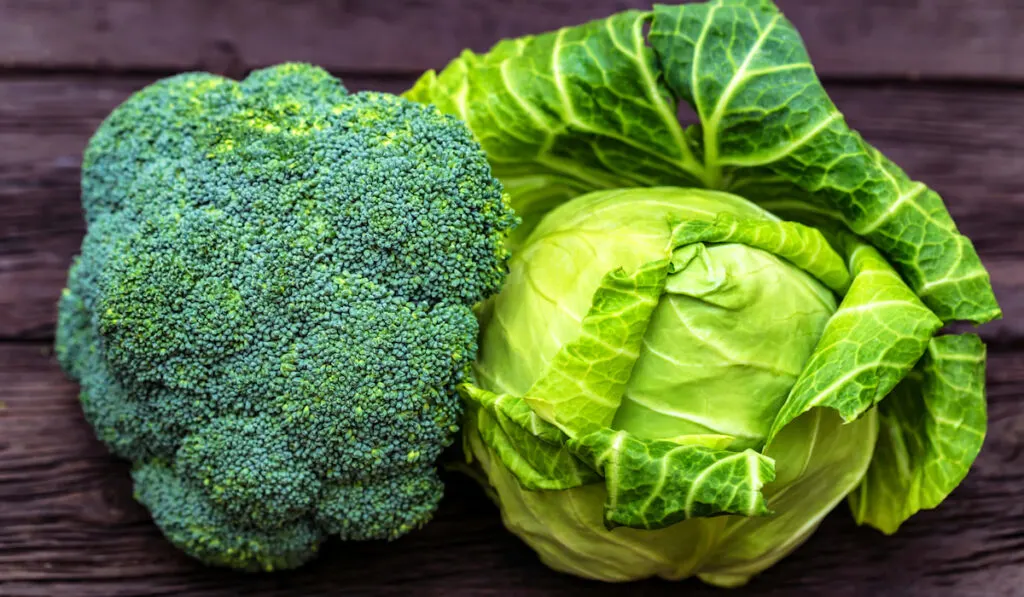
You can offer quail vegetables like cabbage, cucumber, broccoli, carrots, peas, turnip greens, and lettuce.
However, take care with tomatoes. Quail can eat ripe tomatoes but cannot eat any other part of the tomato plant, like the stems and leaves.
Other foods quail love to eat are seeds and nuts. Having some nut or seed-bearing trees around like cascara, ash, oak, or hazelnut will be a benefit to raising your quail. Quail like to eat the seeds and nuts that fall from the tree.
Adult and quail chicks love insects. Chicks and egg-laying hens need the protein insects provide.
Some types of foods are toxic to quail. Avoid anything with caffeine, parsley, avocado, grape seeds, rhubarb, chocolate, meat, the stems and leaves of tomato plants, salty foods, most citrus fruits, and uncooked potatoes.
Keep it Clean
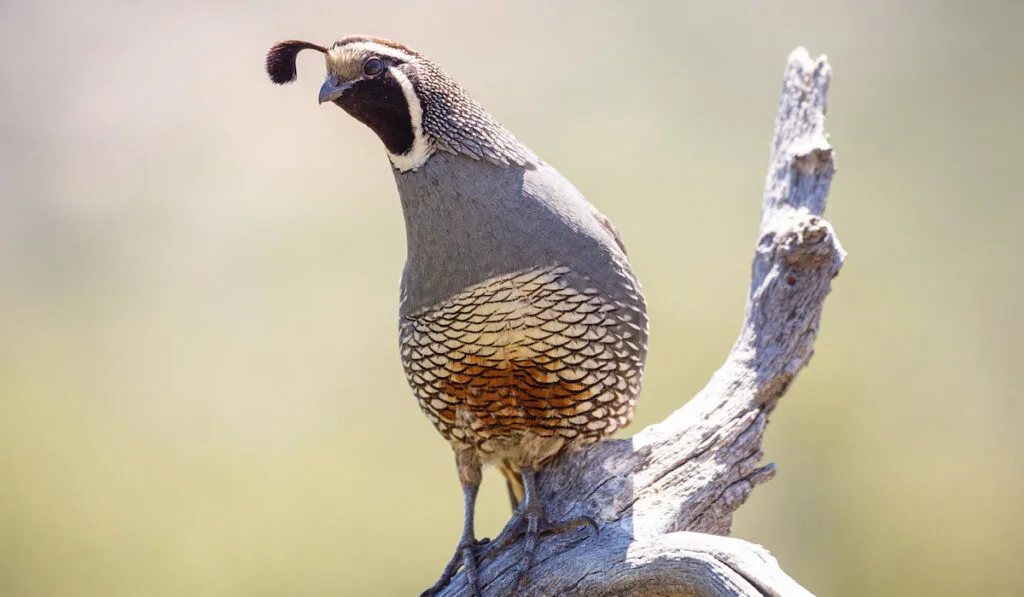
Whether raising quail for eggs or meat, always make sure you regularly clean the feed troughs and keep them dry. You should place the food far away from the water troughs because it can grow mold when the food gets wet, killing your quail.
You should empty the food troughs regularly, wash them when they are dirty or when the food gets wet.
Place the feed trough level with the quail’s crop so they can eat with ease.
Use the linear type troughs that allow lots of space for the quail to eat without competing among themselves for food. Consider buying a hopper feeder with anti-spill attachments because quail can be messy eaters.
Pay special attention to the water troughs, keep them clean and replace the water every day to stop bacteria from growing. You should clean the waterers at least three times a week, use a non-toxic disinfectant and rinse well afterward.
It is good to add some apple cider vinegar to the drinking water now and then. Apple cider vinegar kills parasites and improves plumage.
Store your quail feed in a dry, clean place. When food is not stored correctly, it can get moldy, which can kill quail quickly. It will also attract rats and other critters and insects.
The feed should be used before expiration dates, usually three weeks from the manufacturing date listed on the packaging. When you live in a hot, humid area, you must use the feed sooner. Discard stale or bad-smelling food.
Rats can contaminate the food, so take special care to clean up spills to avoid attracting rats to your area.
Conclusion
It is easy to raise quail, they require less space, food, and care than chickens and other fowl do.
If you follow the tips listed above, you will be able to raise quail successfully in your backyard, farm, or homestead.
Raising quail is profitable as you can sell the eggs and meat easily and they are considered a delicacy by many.
